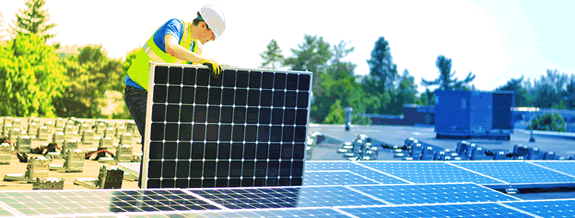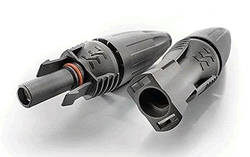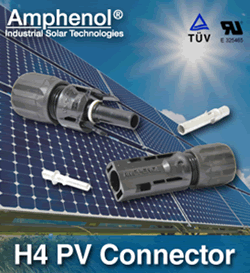Here Comes the Sun – Solar Energy
Solar pricing has dropped to levels that are sparking solid market growth and creating openings for a range of connectors.
By Terry Costlow
Growing interest in sustainable energy technologies, combined with declining prices for solar panels that are more powerful than ever, is sparking solid growth in photovoltaic systems. This growth carries a need for connectors that can meet the extreme reliability requirements that are required over the lengthy lifetimes demanded by utility companies.
Pricing for photovoltaic panels and support infrastructure equipment like inverters and controllers has dramatically declined in recent years. Today, pricing for solar systems competes with conventional energy technologies like coal and nuclear power. Solar-generated power is now the fastest-growing form of energy in the world, accounting for over two-thirds of all new energy capacity. Global solar panel capacity grew by 50% in 2016, with China accounting for more than half of that growth and the US coming in second.

The solar power industry employs 250,000 people in the US. Globally, nearly 10 million people now work in renewable energy.
A report from GTM Research and the Solar Energy Industries Association (SEIA) predicts that the US solar industry will triple over the next five years. The report also states that the US now has 47.1 gigawatts of total installed capacity, enough to power 9.1 million American homes. This year, solar installations will total around 12 gigawatts, representing an 8% gain over last year. The utility-scale segment, which typically accounts for more than half the new installations, has added more than a gigawatt in each of the last seven quarters, according to GTM.
GTM Research currently projects the annual global solar market to reach 85 gigawatts in 2017 — more than double the installed capacity in 2014. These new installations augment sites that are already in operation, pushing the cumulative installed capacity beyond 306 gigawatts worldwide.
India’s photovoltaic market hit 12 gigawatts in 2017 and, according to a Research and Markets study, is predicted to grow at a compounded rate of more than 35% by 2022. Standard and advanced multicrystalline module technology has the highest share in India.
Chinese demand exceeded 34 gigawatts in 2016, exceeding the expectation of GMT analysts and pushing overall global installed solar capacity to just over 78 gigawatts. That’s up from the 51 gigawatts of solar installed in 2015. The performance of China’s solar market also exceeded analyst expectations last year. It flipped the global demand story from an expected 7% global PV market contraction in 2017 to 9.4% growth, with a 5.3% compound annual growth rate through 2022.
The interest is not just in the utility field, where a number of clean energy mandates have boosted market growth. A study conducted earlier this year by Dodge Data & Analytics and the National Association of Home Builders predicted that, in 2022, roughly half the single family and multifamily homes built will use so-called green construction techniques, up from around a third this year.
Solar is playing an important role in net-zero homes, which produce more energy than it takes to build them. In two years, the percentage of builders who used solar panels rose from 19% to 23%. Nearly half (43%) of the builders surveyed expect to use this technology in the future, according to the Dodge-NAHB study. Though homebuilders say there’s more interest, home solar installation have slipped. GTM predicts that the solar industry will add 12.4 gigawatts of new capacity this year, down slightly from their previous forecast of 12.6 gigawatts.
The solid overall growth should bode well for connector manufacturers whose products link panels together and carry energy to inverters. There’s also a strong demand for hardware that links control systems to the power generation devices. Connector suppliers who jumped on the solar bandwagon in years past stand to reap solid benefits from the expanding markets.
Phoenix Contact has designed connectors for field assembly of cabled photovoltaic systems, offering options such as AC connections for micro inverters or DC connections for panels and distribution boxes. DC connections include connectors, feed-throughs and a variety of accessories for circular or rectangular configurations.
 Weidmuller has designed a PV connector that offers crimp-free wiring. Utilizing push-in technology, their innovative PV-Stick, requires no crimp tooling and no stocking of individual contacts. This TUV-approved connector, complies with DIN EN 50521 and reduces installation time by more than 50%.
Weidmuller has designed a PV connector that offers crimp-free wiring. Utilizing push-in technology, their innovative PV-Stick, requires no crimp tooling and no stocking of individual contacts. This TUV-approved connector, complies with DIN EN 50521 and reduces installation time by more than 50%.
 Photovoltaic system offerings from Amphenol Industrial include 4mm Helios H4 connectors that have improved gaskets and a locking design that meets NEC 2008 standards. These connectors also feature self-cleaning, high-efficiency grid contacts and ozone resistance.
Photovoltaic system offerings from Amphenol Industrial include 4mm Helios H4 connectors that have improved gaskets and a locking design that meets NEC 2008 standards. These connectors also feature self-cleaning, high-efficiency grid contacts and ozone resistance.
In solar thermal power plants, HARTING connectors are used on distribution boxes located on the heliostats to collect data and energy. Optical PushPull LC duplex connectors or RJ45-PushPull connector allow exchange of data, while Han® series connectors are used for the power connection.
Continual advances have made solar an increasingly valuable part of our energy supply. This means the opportunities will only grow for specialty connectors to have their day in the sun.
- State of the Industry: 2022-2023 Connector Sales - April 16, 2024
- Amphenol is On a Roll - April 2, 2024
- Nicomatic Proves That Two Heads are Better Than One - March 26, 2024





